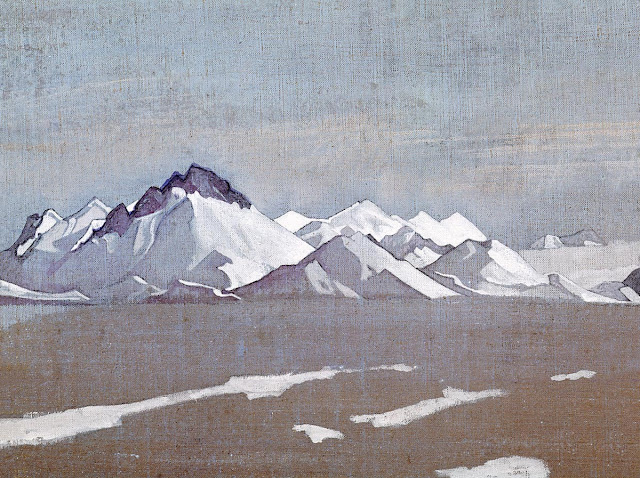GAGANENDRANATH TAGORE (1867-1938)
Massif de l'Hymalayas( 8,8,49 m au Mont Everest)
Bouthan, Chine, Inde, Nepal, Pakistan,
In The Himalayas, 1910, aquarelle sur soie, National Gallery of Modern Art of New Delhi.
Le massif
L'Himalaya, de hima (neige) et ālaya (demeure), littéralement demeure des neiges , est un ensemble de chaînes de montagnes s'étirant sur plus de 2 400 km de long et large de 250 à 400 km, qui sépare le sous-continent indien du plateau tibétain dans le Sud de l'Asie. Au sens strict, il débute à l'ouest au Nanga Parbat au Pakistan et se termine à l'est au Namcha Barwa dans la région autonome du Tibet en Chine. Cet ensemble montagneux, délimité à l'ouest par la vallée du fleuve Indus et à l'est par la vallée du fleuve Brahmapoutre, couvre une aire d'environ 600 000 km2. L'Himalaya abrite dix des quatorze sommets de plus de 8 000 mètres d'altitude, dont le mont Everest, le plus haut de tous ; les quatre autres se situent dans le Karakoram. Ces hauts sommets ont donné lieu à de nombreuses expéditions d'alpinistes renommés et ont tous été conquis. La limite supérieure des forêts se situe à 3 900 m et la limite inférieure des neiges éternelles vers 5 000 m. L'Himalaya fait partie d'un ensemble montagneux plus vaste encore que l'on désigne par « Aire Hindou Kouch-Himalaya » (HKH), laquelle comprend les chaînes du Karakoram, de l'Hindou Kouch et du Pamir. Ce vaste ensemble chevauche huit pays et abrite plus de 140 millions de personnes.
L'artiste
Gaganendranath Tagore était un peintre et
dessinateur indien de l'école du Bengale. Avec son frère Abanindranath
Tagore, il comptait parmi les premiers artistes modernes de l'Inde.
Gaganendranath Tagore est né à Jorasanko dans une famille dont la
créativité a marqué la vie culturelle du Bengale. Fils aîné de
Gunendranath Tagore, petit-fils de Girindranath Tagore et
arrière-petit-fils du prince Dwarkanath Tagore, Gaganendranath était un
pionnier et un représentant majeur de l'école d'art du Bengale. Il était
le neveu du poète Rabindranath Tagore et l'arrière-grand-père paternel
de l'actrice Sharmila Tagore.
Gaganendranath ne reçut aucune
éducation formelle, mais se forma auprès de l'aquarelliste Harinarayan
Bandopadhyay. En 1907, avec son frère Abanindranath, il fonda la Société
indienne d'art oriental, qui publia plus tard l'influente revue Rupam.
Entre 1906 et 1910, l'artiste étudia et assimila les techniques de
pinceau japonaises et l'influence de l'art d'Extrême-Orient dans son
œuvre, comme en témoignent ses illustrations pour l'autobiographie de
Rabindranath Tagore, Jeevansmriti (1912). Il développa ensuite sa propre
approche dans ses séries Chaitanya et Pilgrim. Gaganendranath abandonna
finalement le renouveau de l'école du Bengale pour se consacrer à la
caricature. La Modern Review publia nombre de ses dessins en 1917. À
partir de 1917, ses lithographies satiriques parurent dans une série
d'ouvrages, dont Play of Opposites, Realm of the Absurd et Reform
Screams.
Entre 1920 et 1925, Gaganendranath fut un pionnier des
expérimentations en peinture moderniste.[3] Partha Mitter le décrit
comme « le seul peintre indien, avant les années 1940, à avoir utilisé
le langage et la syntaxe du cubisme dans sa peinture ».[4] À partir de
1925, l'artiste développa un style post-cubiste complexe.
Gaganendranath s'intéressa également vivement au théâtre et écrivit un livre pour enfants à la manière de Lewis Carroll, Bhodor Bahadur (« La Grande Loutre »).
_____________________________________________
2025 - Gravir les montagnes en peinture
Un blog de Francis Rousseau
%20%20The%20Himalayas,%201910s%20Watercolour%20on%20silk.png)
-%20-%20Guru%20Guri%20Dhar.,%201933,%20tempera%20on%20canvas%20,%2085%20x%20124%20cm.jpg)
-%20K2%20%20in%201909.jpg)














